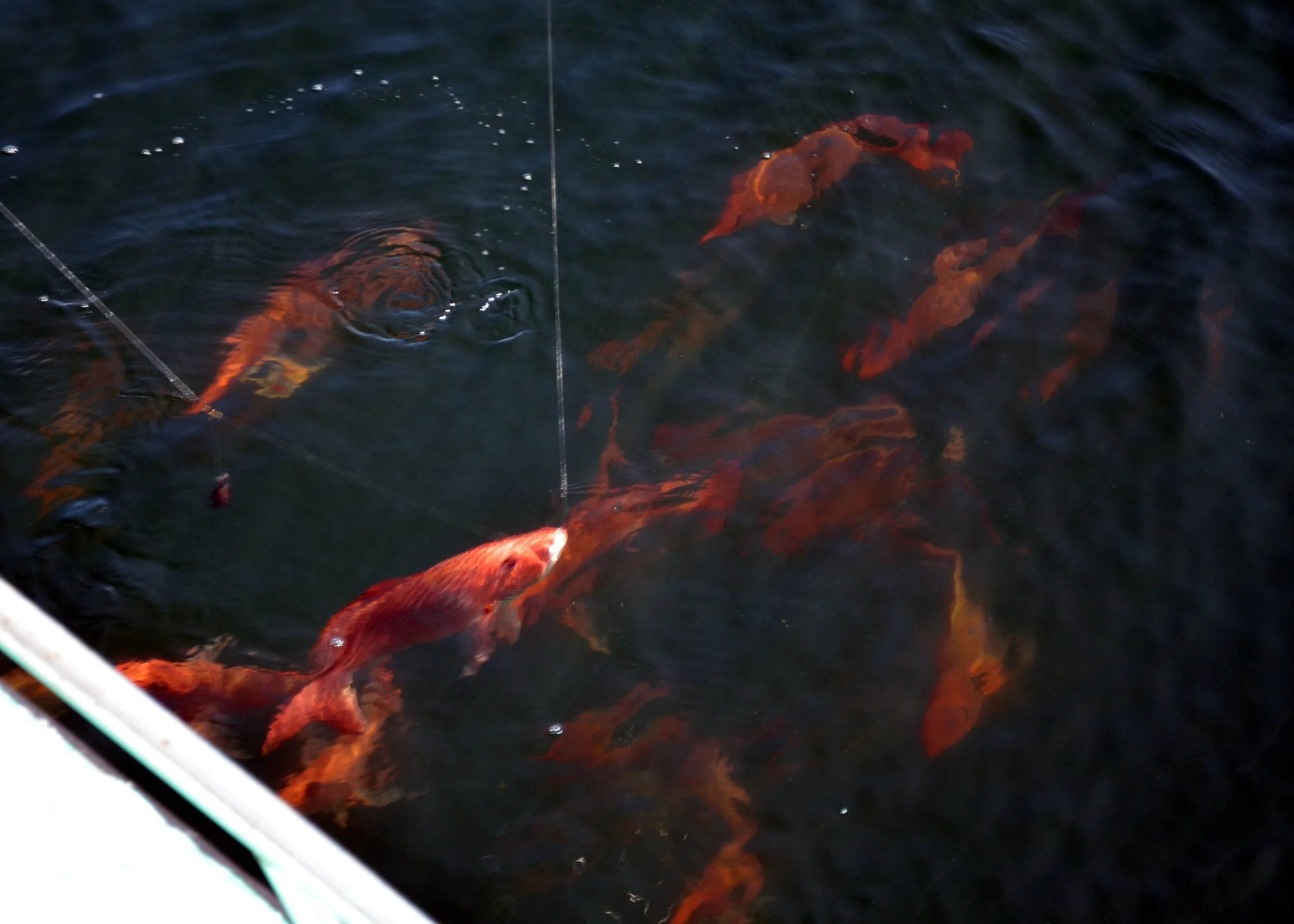Fishing Friday: Texas Winter Offshore Fishing Can Bring Hot Results
By: John N. Felsher
Red snapper swarm around the boat in the Gulf of Mexico. During the winter, snapper frequently come up closer to the surface off the Texas coast. (Photo by John N. Felsher)
For many people, their offshore fishing experience begins and ends with the brief federal red snapper season during the summer. However, in Texas state waters, which extend out to nine nautical miles from shore, one can catch red snapper and many other species all year long.
“Winter is an awesome time to fish for red snapper,” advised Capt. Mike Kubecka of Reel Rush Charters in Bay City. “The big sows come in shallower waters during the winter. I’ve had winter days when we didn’t catch anything weighing less than 20 pounds in state waters.”
Snapper love rocky reefs, petroleum platforms, sunken vessels and other hard structures. In many places along the Texas coast, anglers can find abundant structure in state waters. Anglers in smaller inshore boats can easily reach many places that might hold snapper and other fish species all year long. For Texas reef locations, see tpwd.texas.gov/gis/ris/artificialreefs.
“We usually fish in 45 to 50 feet of water and looking at the beach the whole time,” remarked Capt. Kevin Martin with Surfside Beach Saltwater Charters in Freeport. “In shallow waters, snapper often swim right up to the surface. Even when the current is moving, I try to use the smallest weight I can.”
David Sikes of Corpus Christi, Texas, shows off a red snapper he caught while fishing in the Gulf of Mexico. In Texas state waters, anglers can fish for snapper all year long. (Photo by John N. Felsher)
Over a good reef, most snapper anglers simply drop a tempting meat chunk to the bottom. Popular baits include cigar minnows, menhaden, also called pogies, mullet chunks and squid. Anglers can also catch their own bait. Sand trout make excellent bait for snapper and many other species.
“Our success rate for snapper is extremely high in the winter,” stated Capt. Chad Kinney with Bamm Bamm Charters in Port Mansfield. “We limit out about 99 percent of the time. Around here, we have a lot of natural structure 50 to 90 feet deep in state waters. When a norther blows through, we can’t go fishing offshore in the winter, but two days after a norther, the fishing is much better.”
During the winter, grouper also move shallower. For the best gag grouper fishing, start looking for hard bottom structures in about 225 feet of water. Warsaw grouper generally prefer water at least 250 to 400 feet deep.
“For big grouper, we have to go at least 30 miles out,” Kinney reported. “In January, February and through early March, big Warsaws move into shallower water. I’ve caught a smaller Warsaws, those in the 40- to 50-pound range, in state waters.”
Of course, any reef that holds grouper or snapper might also hold amberjack. During the winter, amberjack sometimes move into water as shallow as 70 feet deep, but for big reef donkeys, start fishing in about 150 feet of water.
One of the biggest artificial reefs in Texas, the 473-foot-long Texas Clipper served as a World War II troopship. It now sits in 132 feet of water 17 miles northeast of South Padre Island. Anglers might also fish the Port Mansfield Liberty Ship Reef about 15 miles east-southeast of the Port Mansfield jetties.
David Sikes shows off an amberjack and Mason Hester shows off a red snapper they caught while fishing in the Gulf of Mexico. Snapper and amberjack both like to hang around deep reefs and other structure. (Photo by John N. Felsher)
“When amberjack season is open, we normally vertically fish with five- to seven-ounce feather jigs ripped through the water,” Kinney recommended. “Sometimes, we go out to deeper structures to fish with butterfly jigs. When jigging, we start right on the bottom. If that doesn’t work, we start moving up about 30 to 50 feet and work that depth. Sometimes, we catch blue runners for bait. In February, we sometimes get a pretty decent wahoo run.”
Even farther out, anglers might tangle with blackfin or yellowfin tuna and other large pelagic fish. Currents naturally circulate through the Gulf of Mexico in a clockwise pattern. The Loop Current flows through the warm Caribbean Sea and then pushes northward through the Yucatan Channel between Cuba and Mexico. Some of that warm water flows westward along the Yucatan Peninsula and then up the Mexican coast into Texas waters.
“If we can catch the water temperatures at 78 degrees or higher in the winter, we have a chance at catching some big pelagic species,” Kinney advised. “It’s definitely a good time for wahoo and yellowfins. We generally catch bigger yellowfins in the winter than in the summer. It’s not uncommon to catch yellowfins averaging 60 pounds with several in the 100-pound class or bigger.”
An angler prepares to gaff a wahoo in the Gulf of Mexico. Winter is a good time to catch wahoo off the coast of Texas.(Photo by John N. Felsher)
While trolling for wahoo and tuna, anglers might also catch bigger surprises. The waters off Texas hold blue marlin all year long, but during the winter, billfish follow the warm currents flowing northward from Mexico. To find billfish, anglers go at least 40 miles out of Brownsville or 60 to 90 miles out of Galveston.
Watch the weather before heading out to fish for anything and check the species regulations for season dates, daily creel and size limits.
Originally from Louisiana, John N. Felsher is a professional freelance writer who lives in Semmes, Ala. An avid sportsman, he’s written more than 2,900 articles for more than 157 different magazines on a wide variety of outdoors topics. Follow him on the internet. He also hosts an outdoors tips show for WAVH FM Talk 106.5 radio station in Mobile, Ala. Contact him at j.felsher@hotmail.com or through Facebook.






